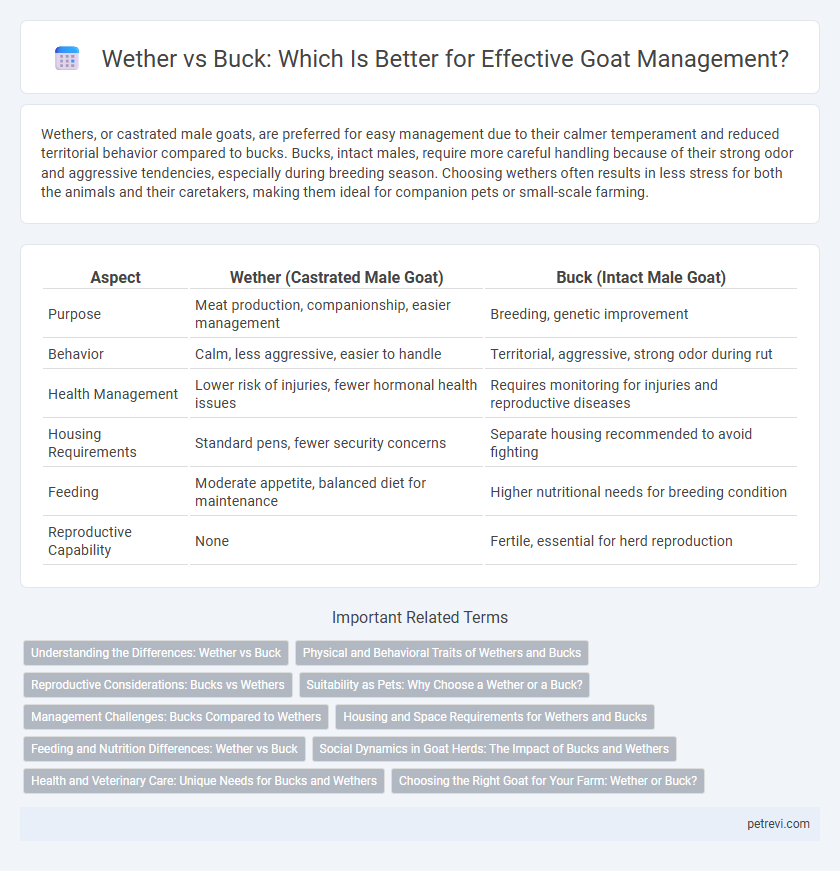Wethers, or castrated male goats, are preferred for easy management due to their calmer temperament and reduced territorial behavior compared to bucks. Bucks, intact males, require more careful handling because of their strong odor and aggressive tendencies, especially during breeding season. Choosing wethers often results in less stress for both the animals and their caretakers, making them ideal for companion pets or small-scale farming.
Table of Comparison
| Aspect | Wether (Castrated Male Goat) | Buck (Intact Male Goat) |
|---|---|---|
| Purpose | Meat production, companionship, easier management | Breeding, genetic improvement |
| Behavior | Calm, less aggressive, easier to handle | Territorial, aggressive, strong odor during rut |
| Health Management | Lower risk of injuries, fewer hormonal health issues | Requires monitoring for injuries and reproductive diseases |
| Housing Requirements | Standard pens, fewer security concerns | Separate housing recommended to avoid fighting |
| Feeding | Moderate appetite, balanced diet for maintenance | Higher nutritional needs for breeding condition |
| Reproductive Capability | None | Fertile, essential for herd reproduction |
Understanding the Differences: Wether vs Buck
Wether goats are castrated males primarily used for meat production, fiber, or as pets, offering a calmer temperament and easier handling compared to bucks. Bucks are intact males known for breeding purposes, exhibiting strong odor and aggressive behavior during the breeding season, which requires careful management. Understanding these differences helps optimize herd dynamics and improve overall goat management strategies.
Physical and Behavioral Traits of Wethers and Bucks
Wethers exhibit calmer behavior and more docile temperaments compared to bucks, making them easier to manage in mixed herds. Physically, wethers lack the pronounced horns, beard, and musky odor characteristic of bucks, which helps reduce aggressive interactions and territorial disputes. Bucks demonstrate more robust musculature and a stronger dominance drive, often requiring separate housing to prevent stress and injuries among other goats.
Reproductive Considerations: Bucks vs Wethers
Bucks provide essential reproductive capabilities in goat herds, enabling natural breeding and genetic diversity, while wethers are castrated males incapable of reproduction, often preferred for easier management and reduced aggression. Bucks require careful monitoring during the breeding season to prevent unwanted pregnancies and maintain herd quality, whereas wethers contribute primarily to herd maintenance and meat production without reproductive risks. Understanding the reproductive roles of bucks versus wethers is crucial for effective herd planning and optimizing breeding outcomes.
Suitability as Pets: Why Choose a Wether or a Buck?
Wethers, being castrated male goats, generally exhibit calmer temperaments, making them more suitable as pets due to their gentle nature and lower aggression levels compared to bucks. Bucks, intact males, can display strong odors and more dominant behaviors, which may require experienced handling to ensure safe and responsible pet management. Choosing a wether often aligns better with families seeking docile, easy-to-manage goats, while bucks may be preferred for breeding purposes or by those equipped to manage their unique care requirements.
Management Challenges: Bucks Compared to Wethers
Bucks present unique management challenges compared to wethers due to their strong odor caused by scent glands, which requires specialized housing and ventilation to control ammonia buildup. Bucks exhibit more aggressive and territorial behaviors, increasing risks of injury and necessitating sturdy fencing and separate enclosures to prevent fighting. Their breeding instincts demand close monitoring during the rutting season to avoid unintended pregnancies and manage stress effectively.
Housing and Space Requirements for Wethers and Bucks
Wethers require less space compared to bucks due to their smaller size and less aggressive behavior, making them easier to house in smaller pens or group settings. Bucks need larger, more secure housing with robust fencing to prevent escapes and minimize conflicts, as their territorial and aggressive nature demand more space for comfort and safety. Proper ventilation, dry bedding, and access to sheltered areas are essential for both wethers and bucks to maintain health and welfare.
Feeding and Nutrition Differences: Wether vs Buck
Wethers, being castrated male goats, have lower testosterone levels, resulting in reduced energy requirements compared to bucks. Wethers typically require higher fiber diets to maintain optimal rumen function and prevent obesity, as their metabolism is slower. Bucks need nutrient-dense rations rich in protein and minerals to support their aggressive behavior, muscle development, and breeding activities.
Social Dynamics in Goat Herds: The Impact of Bucks and Wethers
Wethers, as castrated male goats, typically exhibit calmer and more docile behavior within goat herds, reducing aggressive social conflicts compared to bucks. Bucks retain intact hormones that drive dominant and territorial behaviors, which can disrupt herd cohesion and increase stress among does and other goats. Effective goat management balances the social dynamics by utilizing wethers to promote stability while limiting the presence of bucks to controlled breeding periods.
Health and Veterinary Care: Unique Needs for Bucks and Wethers
Bucks require specialized health management due to their higher risk of urinary calculi and aggressive behavior, necessitating routine veterinary checks focused on reproductive health and horn maintenance. Wethers typically benefit from a calmer disposition and fewer hormonal disruptions, resulting in lower risks of aggressive injuries and easier management of common health issues such as hooves and parasite control. Both require regular vaccinations, deworming, and nutrition balancing to ensure optimal health, but bucks demand more vigilant monitoring for conditions like bloat and testicular complications.
Choosing the Right Goat for Your Farm: Wether or Buck?
Selecting the ideal goat for your farm hinges on understanding the distinct roles of wethers and bucks in goat management. Wethers, castrated males, offer docile behavior, easier handling, and are excellent for dairy production without the risk of unwanted breeding, making them suitable for smaller or mixed herds. Bucks, intact males, provide breeding capabilities essential for herd expansion but require careful management due to their aggressive behavior and strong odor during mating season, demanding dedicated space and supervision.
Wether vs Buck for Goat management Infographic

 petrevi.com
petrevi.com